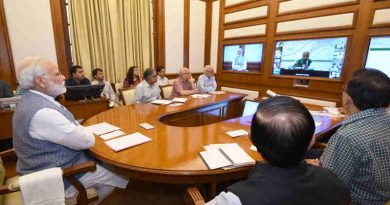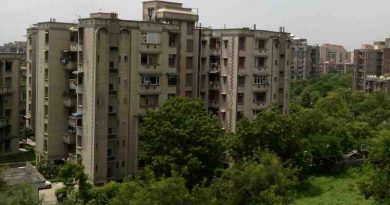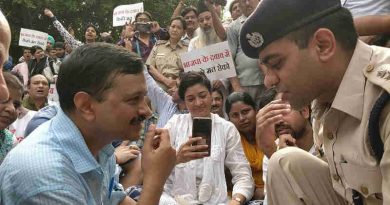Government Plans Congestion Tax on Private Vehicles in Delhi

If the government really wants to remove polluting vehicles from the country – or particularly Delhi – it must impose some back-breaking penalties on car owners.
A high-powered committee on ‘Decongestion of Traffic in Delhi’ has called for a paradigm shift in transport planning and policy interventions to check explosive growth in automobile population in the national capital and move people more efficiently than cars through effective public transport system.
The Committee set up by the Minister of Urban Development, M.Venkaiah Naidu in October, 2014, further to media reports on the havoc being caused by traffic congestion came out Sunday (June 5, 2016) with a 126-page comprehensive report analyzing the causes and consequences of traffic congestion and suggesting a way forward.
The inter-ministerial committee, headed by Rajiv Gauba, Secretary (Urban Development) with representatives from 19 different ministries and agencies of Central and Delhi Governments, Delhi Police and all the Urban Local Bodies held several rounds of deliberations and submitted a unanimous report on ways and means for decongesting Delhi’s traffic.
The increasing number of cars is a major irritant in Delhi. Even the Delhi High Court has ruled that only one car per flat will be allowed in housing society parking lots.
But Delhi government has failed to check the menace and playing hand in glove with the corrupt managing committees of the housing societies that allow residents to park multiple vehicles inside the society premises or on open pavements under some secret deals with the erring residents.
Noting that 21% of city’s area is already under roads with limited scope for road network expansion, 60% of passenger trips are below 4 km distances and 80% below 6 km lengths which are ideal for non-motorised transport, the committee strongly recommended development of necessary infrastructure for promoting walking and cycling in the national capital.
Related Articles:
[ New Delhi: Where Deadly Pits Are Called Roads ]
[ स्कूल बेकार, पढ़े–लिखे बेरोजगार, यह है दिल्ली सरकार ]
[ Welcome to the Smart City of Stray Dogs ]
[ Is Arvind Kejriwal an Enemy of Delhi? ]
It also opined that automobile centric planning with focus on road widening, construction of more and more flyovers, foot over bridges, under-passes, etc. have only promoted increased use of private vehicles which are meeting only less than 20% of transport needs and should not be encouraged unless warranted by natural barriers like rivers.
The committee also expressed serious concern over mushrooming of gated communities in the city which are compelling local traffic to come onto main roads by preventing short cuts for movement of people.
[ Is New Delhi the Dirtiest City of the World? ]
The committee called for various interventions over the next five years to enable 80% share for public transport and non-motorised trips in total transportation in the city where in the total passenger trips are estimated to increase to 280 lakhs per day in 2021 from a mere 45 lakh trips in 1981, 118 lakh trips in 2001 and 144 lakhs in 2008.
In the current phase of neo-industrialization, where the world is running faster than you think to embrace an economic model driven by hyper mechanization, people are ignoring their most formidable enemy – POLLUTION – that is constantly chasing them.
The committee concluded that the explosive growth in automobile population needs to be checked quickly by adopting a ‘carrot and stick’ policy of enabling increased use of public and non-motorised transport and disincentivising use of private vehicles through deterrent parking pricing and Congestion Tax.
Expressing concern over 18 different Central and Delhi Government departments and agencies handling different aspects of transportation in the city region, the committee recommended a Unified Metropolitan Transport Authority for better coordination, quick decision making and execution.
[ Also Read: Construction Causing Deadly Pollution in Delhi: NGT ]
To ensure a safe, sustainable, affordable, equitable, comfortable, accessible and environmental friendly public transport system in the city, the committee recommended a four pronged strategy with the components of :
1. Improving Public Transport and Disincentivising use of private vehicles;
2. Promoting Road Safety and efficient Traffic Management;
3. Setting up Unified Metropolitan Transport Authority and enhancing institutional capacity; and
4. Promotion of Transit Oriented Development through integrated land use and transportation planning.
The recommendations of the committee under these 4 components of the Strategy include:
1. Fully paid rented or owned parking with parking fee based on area of the city, duration and size of the vehicles;
2. Paking on footpaths to be made cognizable offence under Delhi Municipal Corporation Act;
3. Penal charges for parking violations to be 10 times the normal rates;
4. Parking Management Districts to be planned for all public places and one agency / operator to handle both on street and off-street parking for better management;
5. No stand alone parking slots to be developed;
6. Shared parking to be promoted for effective use of parking sites during different periods of the day;
7. Promotion of feeders services and bringing informal feeder services under legal framework;
8. Mandatory provision of footpaths on all roads as per codes with right of first use of street space to pedestrians;
9. Provision of more crossings for pedestrians and cyclists, at least at every 250 metres;
10. Signal free corridors to be avoided as they invite more private vehicles on to roads;
11. More secondary street networks to be created by avoiding creation of gated communities for providing shortcuts to pedestrians;
12. Access to bus service should be within walking distance from home or office;
13. Bus fares should be priced less than per km. cost of running a two wheeler;
14. Multi-level bus parking to be provided at all depots; multi-modal, multi-use bus depots on public-private partnership (PPP) basis to be taken up for high class services and terminal experience for passengers;
15. For Delhi, 2,000 buses should be procured immediately and 4,000 in the next phase;
16. Intelligent Transport System be adopted for surveillance, automatic vehicle location, public information, Red Light Camera and Stop Line Violation Detection, Automatic Number Plate Recognition, Automatic Parking Management and Intelligent Signaling for synchronized movement of vehicles across different signals, etc.
17. Operational Control Centre to be set up for real time monitoring and management of traffic on all roads and sharing actionable information to different service providers including Delhi Police for automatic issue of challans for violations;
18. Effective traffic management through better traffic dispersal by enabling more junctions, junction improvement, provision of roundabouts, removal of choke points, segregation of long haul and short haul traffic, promotion of secondary road networks;
19. Commissioning a Freight Audit of the city based on analysis of consumption behaviors of citizens and availability of key supplies and movement of goods for evolving a freight plan for the city;
20. Engaging high quality professionals for in-house technical assistance for better planning and execution of projects;
21. Preparation of comprehensive and integrated Land Use Transport System on priority basis;
22. Improving regional connectivity through integrated Regional Rapid Transport Systems; ensuring full utilization of Sub-urban ring rail system including for freight movement and decongestion at major railways stations
23. Enabling quick start of Transit Oriented Development Projects (TOD) for reducing mobility needs and enabling access to public transport for long distance travel;
24. Development of BRTS (Bus Rapid Transit System) corridors on high density routes; and
25. Creation of Urban Transport Fund for Delhi for tapping various revenue streams like parking charges, fuel taxes, advertisement incomes, etc. for augmenting bus services.
If the government really wants to remove polluting vehicles from the country – or particularly Delhi – it must impose some back-breaking penalties on car owners.
The interventions recommended by the committee for improving public transport in the national capital at an indicative total cost of Rs. 19,762 cr include: Development of 7 pilot Paking Management Districts under PPP – Rs.70 cr, Multimodal Integration of 207 Metro stations – Rs.4,957 cr, Cycle tracks and foot paths – Rs.2,300 cr, Cycle sharing projects – Rs.1,715 cr, BRTS and Bus service improvement – Rs.6,760 cr, Removal of choke points, Junction improvement and providing missing links to enable commissioning of near finished projects – Rs.3,250 cr (this has already been provided by the Ministry of Urban Development under Urban Development Fund) and Capacity Building – Rs.40 cr.
The number of private vehicles, cars is increasing at a staggering annual rate, thanks to a plethora of car-loan schemes, unrestrained urbanization, and unaccounted for money with many Indians in the absence of regulations.
Five BRTS Corridors recommended by the Committee for priority consideration are: Karwal Nagar – Moti Gate (12.90 kms), Gazipur NH-24 – National Stadium (12 kms), Dishal Garden Metro Station – Tikri Border (40 kms), Badarpur Border – International Airport via Mahipalpur (26.10 kms) and Harsh Vihar – Janakpuri District Centre – Janakpuri D Block (33 kms).
The committee recommended execution of the following projects in the next two years to provide immediate relief: Implementation of Parking Management Districts for Connaught Place (management plan only required to be evolved), Nehru Place, Karol Bagh, Kamla Nagar, Vikas Marg, Lajpat Nagar and Bhikaji Cama Place, multi-modal integration of 78 Phase-III Metro stations, Integrated Passenger Terminals at Sarai Kale Khan, Bijwasan and Anand Vihar, development of 200 kms of cycle tracks and footpaths, improvement of 200 junctions, purchase of 2,000 buses, implementation of Kakardooma and Sanjay Lake TOD Projects, Intelligent Transport Systems, operationalisation of UMTA, etc.
Projects to be implemented in the next five years include: Multi-modal integration of 129 Phase I and II metro stations, Integrated passenger terminals at Kashmere Gate, Holambi Kalan and Tikri Kalan, 500 kms of cycling and walkways, development of 200 more junctions, five BRTS corridors, improvement of geometry of 400 junctions along with IT system for surveillance and vehicle systems, TOD projects at Dwaka, Narela and Rohini.
The committee also recommended setting up of a committee headed by Chief Secretary, Government of NCT of Delhi with representatives of other stakeholders for monitoring the implementations of various recommendations for decongesting traffic in Delhi.
Photo courtesy: Ministry of Urban Development, Government of India




